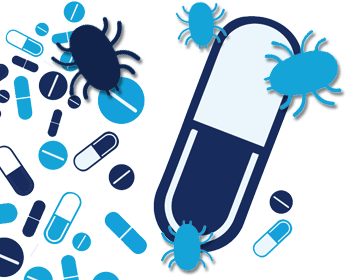We know we should be more careful about appropriate antibiotic use for people, domestic and farm animals to avoid increasing antimicrobial resistance. But how exactly should we be more careful? And how come the solution isn’t the same for everybody? Gentec-associated researcher Ellen Goddard tackled some of the thorny questions around behaviour change at a UCalgary One Health webinar on November 17.
One Health has a very complex definition but we tend to think of it as relating to zoonotic diseases, especially diseases from wildlife. The principal drivers for the emergence of zoonoses are human activities such as agriculture, travel, trade and land use.
So almost everybody is affected by the definition but an office worker in downtown Toronto may not feel the same connection as someone who works directly with animals, be they farmed, domestic or wild. That very context colours our approach to potential solutions.
Farmers, for example, are directly involved. If you’re a farmer, you’re probably convinced that you’re behaving in the best way possible to protect your animals, the environment and the health of your family. You’ve learned and studied as much as you can from your neighbours, extension agents and vets. So if somebody shows up on your doorstep saying that you need to change your habits around antibiotics completely—and you’ve always used antibiotics successfully to protect your animals—that idea is not going to go down well. That may be because you don’t fully understand the connection between antibiotics and the development of antimicrobial resistance. Or because you don’t see that the actions you take on your one farm also affect the soil, waterways and wildlife far beyond it.
So complexity is one of the fundamental things that discourages behaviour change.
Another is that, at the end of the day, we are dealing with people, individuals and society’s approach to the use and care of animals. We all have views about animals: they are created in our youth, through cultural ties, schooling, etc.—and they almost never change. If we’re raised to believe that animals need protection and care, that applies to all animals. If we find out that they are being mistreated or subjected to actions that we interpret as mistreatment, we are likely to respond very strongly.
For example, culling animals is one of the most effective ways of limiting the spread of disease, whether to protect domestic or farm animals, wildlife or humans. As scientists, this is obvious. That’s what the data say. But if half of society has strong, fundamental, ethical beliefs about not mistreating animals and the authorities are going to cull a large number of wildlife, you can bet the reaction will be angry and hostile. This is a perfectly rational response from people who believe protecting animals is ethical. And they think they’re doing the right thing.
An example of this is the badger cull in the UK. Badgers are a protected species, so the public can’t get its head around the idea of culling them because they are bringing tuberculosis onto livestock farms. Badgers need protecting, period. That said, the public supports vaccinating the badgers (this is doable). On the other hand, farmers are desperate for protection from this disease. They want the culls. Once again, the data show that, in areas of the UK where culling has taken place, the rate of cattle infection from tuberculosis is lower. So farmers say, “See? Culling works.” Then the decision falls into political hands, and citizens feel undermined because their position, contribution and voice aren’t valued.
An example closer to home is chronic wasting disease (CWD) in cervids. Deer are far removed from most people’s lives these days, so you’d think the public would have no interest in culling decisions. The Alberta government tried that—and there was a huge pushback. People simply didn’t like the idea of killing huge numbers of deer and elk. Setting the cull aside for a moment, CWD hasn’t been shown to affect livestock or humans but we don’t know if that will change or what the long-term implications are. Farmers say they like the idea of deer and wildlife on their property. They worry that if CWD is transmissible, they would have to act to stop the deer/human/animal interaction. They like that their farms are private property, not accessible to others. It makes them feel they can control some aspects of their environment. So we have to understand what motivates people to change their behaviour when an issue of animal health may affect the public.
From our surveys, we know that everybody opposes taking NO action; but hunters, outfitters and the public differ hugely on the type of action to take. If you make your livelihood on something that will be restricted, you will feel more strongly than the said office worker in Toronto. So individual behaviour influences the success of any One Health strategy. If we don’t come up with multifaceted solutions, we will fail because, particularly in the context of animals, people have strong feelings that drive whether they accept or reject solutions.
That’s why it’s so important to do behavioural modelling to test strategies that may be successful. We need to understand what drives people’s behaviour, pick the strategies that encourage change, and tailor them to groups and individuals on the front lines. This will be essential if we’re going to apply One Health in a way that benefits the world to come.

